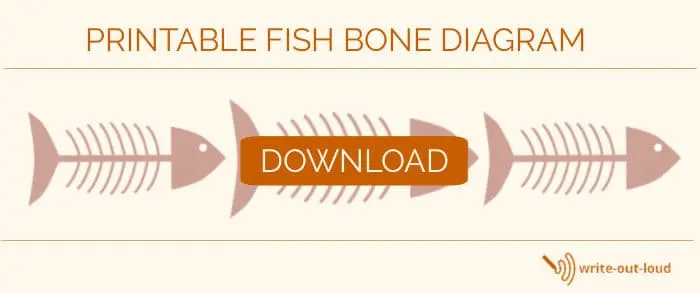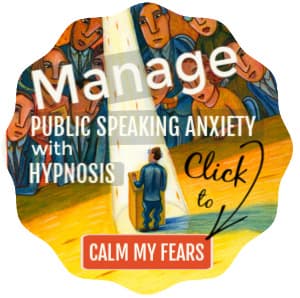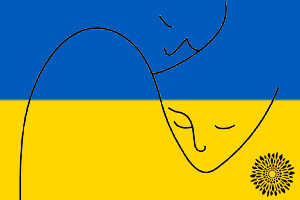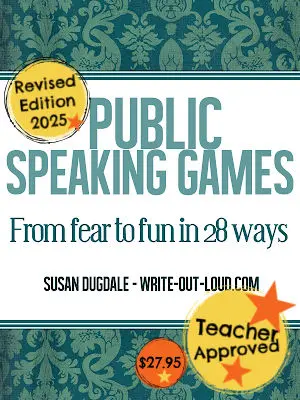- HOME ›
- Speech topics ›
- 145 cause and effect topics
145 good cause and effect topics
Captivating cause and effect ideas for student speeches and essays
By: Susan Dugdale
Cause and effect topics explore actions and their consequent reactions. They explain why something happened.
For instance, cause and effect analysis helps us understand questions or topics like:
- Why does the sun set?
- What are the consequences of being popular?
- Why was there another World War (1939 – 1945) after World War One (1914 - 1918), which was supposed to be the ‘War to End All Wars’?
Anything, and everything, can be looked at in terms of cause and effect.
There are 145 themed, good cause and effect topics here - suitable for either a speech or an essay.
In addition, there's explanations of terms, examples and other material to help you prepare the best speech or essay you possibly can.
Challenge yourself! Choose a topic that connects in a real way with your audience and make your assignment count. ☺
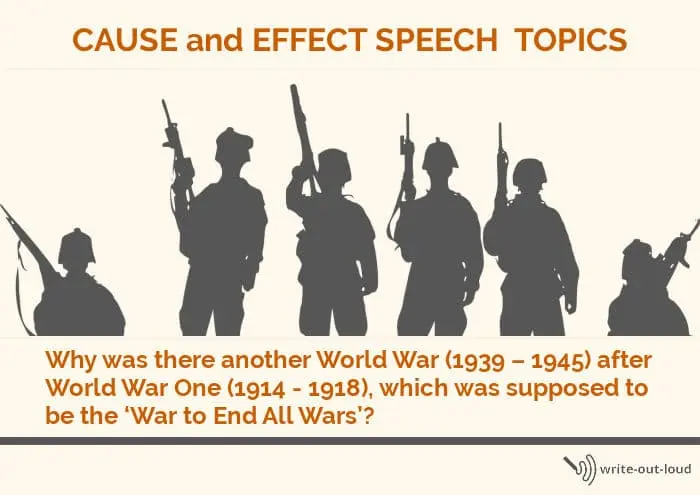
Use the index to navigate this long page easily
Find an interesting cause-and-effect topic
- All cause-and-effect topics - jump to the first of the themed lists and scroll through them all.
Or go to a themed list. - 21 personal cause-and-effect essay or speech topics
- 33 education and society cause-and-effect topics
- 25 environmental cause-and-effect topics
- 22 history cause-and-effect topics
- 14 natural science cause-and-effect topics
- 28 medical cause-and-effect topics
- Other resources to help with preparing your speech
Understanding and working with cause-and-effect
Use the links in this section to find out more about cause-and-effect.
- What are causes? What are effects? An explanation of cause and effect & the causal chain
- Cause-and-effect analysis made easy with a Fish Bone Diagram – a useful, effective visual tool to aid understanding more complex events (with a blank printable Fish Bone diagram to download)
- Signal words and phrases for cause-and-effect topics
- The reasons for setting cause-and-effect topics for speeches or essays
- Crooked cause-and-effect thinking – logical fallacies, with examples
What are causes? What are effects?
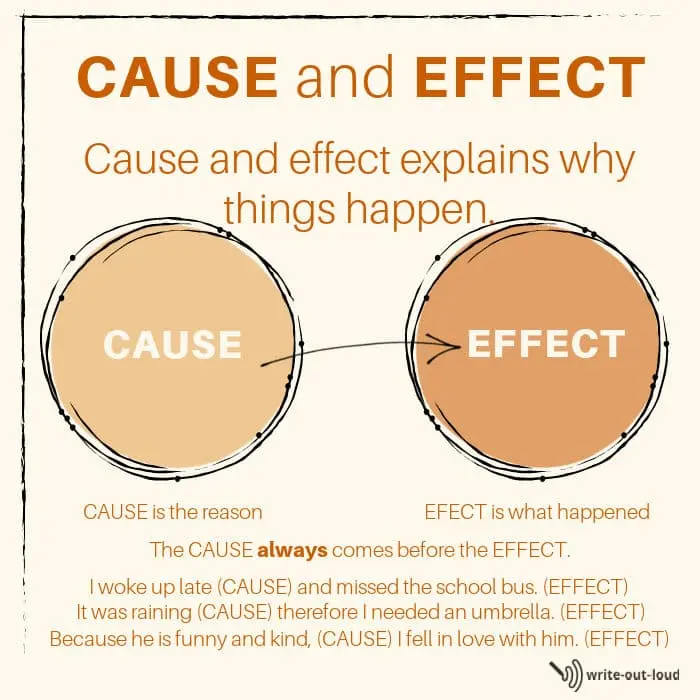
A cause is the catalyst setting up, triggering, or initiating a response. It always comes first.
The response or result is the effect or consequence of the cause. It always follows.
Here’s a very simple example.
When the door slammed shut on my finger, I yelped in pain.
The cause is the ‘why’ preceding, coming before, the effect, the ‘what’.
‘The door slammed shut on my finger’ is the cause, or the reason why 'I yelped in pain’.
‘I yelped in pain’ is the effect or what happened as a consequence of the cause.
Cause-and-effect cannot exist without each other
Either one cannot exist without the other. There is no effect without a cause or a cause without an effect.
Absolutely everything is part of an ongoing causal chain: cause followed by effect followed by cause followed by effect, followed by...
The causal chain: ongoing cause-and-effect
To illustrate here’s my 'the-door-slammed-on-my-finger' example continued. The effect becomes the cause giving rise to a new effect. And so, it rolls on.
When I yelped in pain, (cause) I gave my colleague such a fright she spilled her coffee. (effect)
When she spilled her coffee (cause) it splashed all over the notes she was getting ready to take to a meeting. (effect)
Because her notes were covered in coffee stains, (cause) she had to print them out again. (effect)
Because she had to print them out again, (cause) she was late for her meeting. (effect)
Cause-and-effect analysis - Fish Bone Diagram
An effect may have one or multiple causes, and one cause may have multiple consequences.
For example, the outbreak of World War Two (the effect) did not have a single cause. Although the actual declaration of war between Britain and Germany was triggered by Germany invading Poland, that was just the immediate cause – the one prior to the event. Many more preceded it.
A fish bone diagram, a visual analytical tool, also known as an Ishikawa diagram after the man who invented it, will help you get a good clear overview of a complex topic like this one.
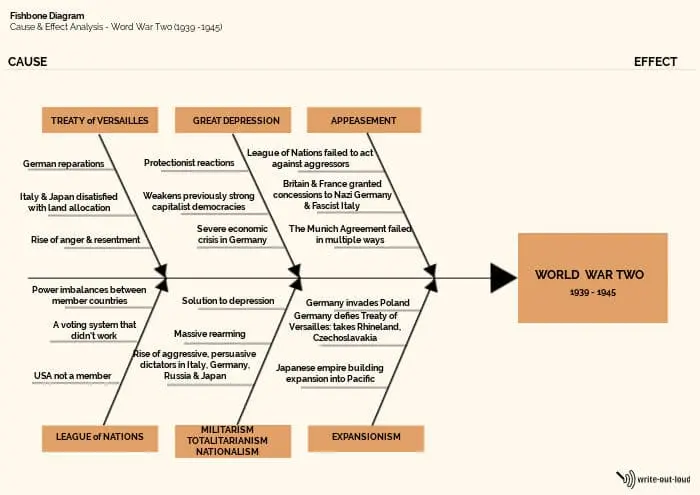
As you can see, the diagram takes its name from the skeleton of a fish.
Each major ‘bone’ arising from either side of its central ‘back bone’ represents one broad category or cause. Each of these categories or causes can be broken down into smaller ‘bones’ - a sub-set of causes within the major ones.
They all combine to cause the event named in the rectangle representing the head of the fish.
Cause-and-effect analysis World War Two
The diagram clearly shows there were many more reasons aside from Germany invading Poland that led to another world war, only twenty-one years after the end of the first.
The initial cause was the way the defeated countries were dealt with by the victors and how the victors treated one another at the Paris Peace Conference in 1919 where the details of the Treaty of Versailles were worked out.
Italy and Japan, allies of Britain, France and America, were dissatisfied with their outcomes while the conditions of the Treaty that Germany was forced to sign were deliberately humiliating. That simmering discontent eventually emerged as the rise of fascism in Italy, Nazism in Germany and statism (a mix of nationalism, militarism and “state capitalism”) in Japan.
And that's only part the story: the beginning. To give the full picture we have to add the categories or causes, as yet unmentioned: the failure of the League of Nations, the Great Depression, expansionism and the policy of appeasement.
Get a printable fishbone (cause and effect) diagram
A completed fish bone diagram will give you an outline of the body of your speech or essay. It makes preparing your text, the words you're going to say or write, so much easier!
Add the conclusion and an opening and you’re ready to rehearse it.
Once you've chosen your topic get a printable blank fishbone diagram for your own use.
Signal words and phrases for cause-and-effect topics

Words that communicate the relationship between causes and their effects are called signal or transition words.
They’re signaling (telling) listeners (or readers) to connect the cause(s) with the effect(s). Or to put it another way, to make the transition linking or bridging the cause(s) and the effect(s).
Signal words make it easier for people to understand what is being said. For that reason, you’ll want to use them in the piece you’re preparing.
Here are three examples. The signal words are highlighted.
As a result of his thorough preparation, he easily passed the test.
Because it’s raining, we’ve cancelled the picnic.
Due to Covid, we’ve been working from
home.
The benefits of cause-and-effect topics for speeches or
essays
Why do your teachers set cause-and-effect types of essays or speeches? (And the answer is not because they absolutely adore assessing their student's work. ☺)
It's because cause-and-effect assignments will help you:
- develop logical critical thinking skills
- learn to dive deeper into a subject – to go beyond the superficial, to be curious, to ask why rather than be satisfied with an initial, sometimes overly simple, explanation
- learn to systematically analyze the causes of the problem you're looking at, rather than be overwhelmed by it and not know the best way or where to start
- learn to make and test connections to see the different ways things work, or don’t work, together
Crooked cause-and-effect thinking: 2 examples
Because a cause comes before an event, we might be tempted to think a particular cause is the reason the event occurs. It may seem logical. But that is an assumption, one that is not always either trustworthy or the full story!
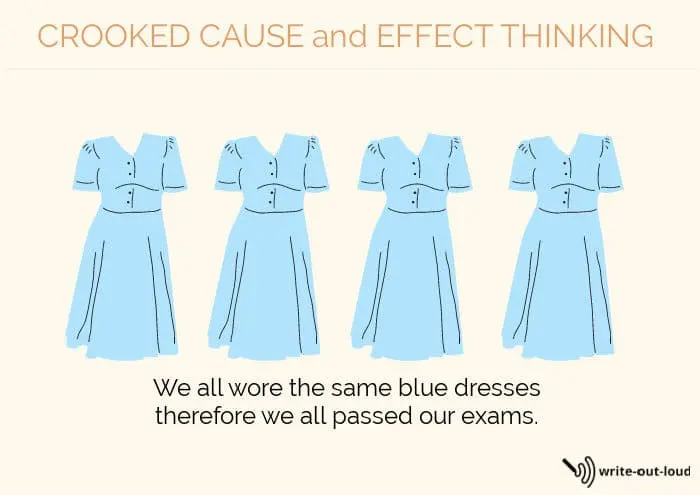
For example:
We all wore the same blue dresses and therefore we all passed our exams.
Really? Is wearing blue dresses why you all passed?
Did you all revise and study for the examination?
Did you all come refreshed, on time and ready to do your best?
That you all wore blue dresses is immaterial - a false correlation that has no bearing on the outcome. It is purely co-incidental!
Or:
He crashed the car because it was raining.
Did the rain really cause him to crash? Or were there other reasons that could have played a part?
Was he driving too fast?
Was he over tired or overwrought? Maybe he’d worked a double shift or had a major argument.
Was he driving under the influence of either a drug or alcohol?
Was he a licensed driver?
Could he see clearly?
What was the condition of the road? Did he swerve to avoid a large pothole?
Was there stock on the road? Escaped cattle from a farm bordering the road?
Had the car been serviced recently? Were the brakes working as they should?
Both are examples of logical fallacy: a faulty cause and effect connection. A fallacy is a mistaken belief based on unsound arguments and in these instances, the logic was flawed.
21 personal cause-and-effect essay or speech topics
Use these personal cause-and-effects essay/speech topics to explore your own experiences. Share the positive and the negative aspects to give a balanced response.
- The impact of having a single mother or father
- The impact of being an only child
- The impact of having red hair or some other physical attribute that causes you to stand out from other children
- The impact of playing a sport on physical and mental health
- The impact of being a middle child
- The various effects of being the child of older parents
- The consequences of being anxious
- The consequences of being poor
- The impact of being popular
- The consequences of being neuro-diverse – having a brain that functions differently to what is generally considered 'normal'
- The impact of telling a lie
- The impact or consequences of being a refugee
- The effect of having a pet
- The consequence of consciously setting goals
- The effect of having an after-school job
- The consequences of having been home schooled
- The results of overcoming a limiting fear – for example public speaking, water,
- Why some people become bullies
- The effect of being stereotyped because of where you come from, your language, and the clothes you wear
- The personal positive impact a person, book, song, or movie has had on you
- How the pandemic changed your life
33 education and society cause-and-effect topics
The following topics ask you to examine the various causes and effects shaping education and society.
- How a school's social standing or reputation effects its students
- Why are some people tempted to cheat on a test, or an exam?
- How social media platforms have changed how we interact with each other.
- Why the concept of a 'typical' family is under threat
- Why sending people to prison is not going to help them change
- Why the sustainable fashion movement is necessary
- Why we need to pay people a living wage
- Why the voting rate is falling
- How poor housing reinforces poor behavior
- How educational success underpins personal success
- Why all schools should have uniforms for their students to wear
- The impact that the pressure to get good grades has
- How food insecurity impacts behavior
- What's causing so many people to live on the street or in their cars?
- How smiling (or scowling!) changes how we feel
- Why smart phones are necessary
- The rise of online classes and the impact it has
- How teachers impact on their students
- How playing video games improves cognitive ability, hand-eye coordination, as well as problem solving skills and logic.
- How instant communication via smart phones leads to reactive rather than thoughtful responses
- How being around and personally witnessing regular violence normalizes it
- How being part of a gang can be vital for survival
- The rise of influencers and their impact
- How feminism has changed the way we think and live
- How community housing, gardening, schooling, or food co-op ...initiatives make a positive difference
- The causes and impact of the spread of fake news and alternate facts
- How social media has normalized cancel culture
- How the use of AI (artificial intelligence) could/does impact on academic writing and scientific research.
- How being a 'good man' is harder than it was 60 years ago
- Why a social welfare catch net is necessary
- What social issues cause students to drop out of school?
- How do school shootings impact communities?
- The ‘woke’ revolution/phenomena – its causes and possible effects
25 environmental cause-and-effect topics
It’s a small world after all! What happens on one side of it effects the other. These topics look at issues around how we understand, live with and manage our natural resources.
- How plastics effect marine life
- How using/burning fossil fuels add to our climate change problems
- How being able to buy carbon credits is nonsensical
- How the current rate of deforestation is unsustainable
- How mono-cropping can cause problems
- How sustainable farming practices are healthier for people and our environment
- How owning land gives a person the right to do with it what they wish
- Why we need to stop eating animal proteins
- How food waste is one of our biggest environmental problems
- The 'before and after' impact of the rise of water bottling industry
- What are the real reasons behind the increased risk of famine, droughts, floods or forest fires? Is this the impact of environmental pollution?
- How does the weather effect people? Is there clear evidence that it can alter their moods?
- How accepting 'ugly' fruit and vegetables will lessen the amount of food we waste
- How changing natural habitats like forests, grasslands and mangroves into land for agricultural use increases the loss of bio-diversity
- How electric vehicles will help lessen air pollution
- A detailed 'before and after' example of how sustainable farming practices have positively changed the environment
- How plants communicate with each other
- How fast fashion contributes to climate change problems
- The cause and effect of holes in the ozone layer
- Why dumping toxic waste of any sort anywhere should be a crime
- How to change climate change one person and one step at a time (Things an individual can do to make a difference.)
- How noise pollution in the environment damages physical and mental health
- How ‘green washing’ adds to and prolongs environmental damage
- How climate/environmental activism makes a positive difference
- How traces of toxic chemicals are unavoidable in the foods we eat
22 history examples of cause-and-effect topics
Danish philosopher and theologian Søren Kierkegaard is frequently given the credit for the saying: ‘Life can only be understood backwards; but it must be lived forwards.’
In essence, it’s about the dilemma of only being able to get a clear overview of an event once it is passed yet having to live in the present. Hindsight – the ability to look back and reflect on the past, to see and analyze the patterns of action and reaction, helps us to understand why we are where we are now.
- What were the main causes-and-effects of the development of the first printing press?
- What was the cause and impact of previous pandemics for example, The Black Death in 14th century Europe, or the Influenza Pandemic of 1918-19?
- What were the causes and main impacts of the Great Depression 1929 – 39?
- What were the drivers behind the work of the early feminists like Emmeline Pankhurst or Florence Nightingale? What impact did their work have?
- What lay behind the work of the early abolitionists? What drove them?
- What were the main causes and effects of the Temperance Movement in USA?
- What caused the Irish Potato Famine of 1845-1849?
- What was the cause-and-effect of the 1941 Japanese bomber attack on Pearl Harbour, Honolulu?
- What are the principal causes-and-effects of the Civil Rights Movement?
- What are the main causes-and-effects of colonialism?
- What were the principal causes-and-effects of the rise of Nazism in Germany?
- What were the main causes-and-effects of the US dropping atomic bombs on Hiroshima and Nagasaki?
- What were the causes-and-effects of having modern plumbing in houses?
- What were the causes-and-effects of developing contraceptives?
- What were the causes-and effects of women gaining the right to have their own bank accounts?
- What were the main causes-and-effects of harnessing electricity for domestic and public use?
- What were the main causes-and-effects of discovering penicillin?
- What were the main causes-and-effects of developing safe anesthetics?
- What were the main causes-and-effects of the advent of the internet?
- What were the main causes-and-effects of developing nanotechnology?
- What are the main causes-and-effects of DNA testing and sequencing?
- What are the main causes-and-effects of online shopping?
14 natural science cause-and-effect topics
How does our natural world work?
Why are there stars in the sky?
If the earth is spinning so fast, why don’t we fall off?
What fascinates you about where we live? Use this topic selection as a starting point to find one you want to explore.
- The cause-and-effect of the tides
- The cause-and-effect of the shapes and types of clouds in the sky
- Why volcanoes erupt
- Why an earthquake occurs
- The impact of music on plants
- Why and how rock of varying types are made
- Why some animals, birds, fish and insects migrate
- Why the seasons occur
- Why does it rain?
- What creates (causes) specific environmental communities
- What causes a lightning strike
- The cause-and-effect of rivers on their environment
- What adaptions do plants, insects or animals make in order to live and survive in their environments
- What causes a plant, bird, animal, insect or fish to become extinct?
28 medical cause-and-effect paper topics
The general theme of these topics relates to the science or practice of medicine.
- Why an eating disorder is a cry for help
- Why junk food is so good and so bad all at the same time
- How sedentary lifestyles contribute to ill health
- How lack of access to contraceptives effects the quality of people's lives
- How refusing vaccines keeps potentially lethal diseases circulating in communities
- How the lack of medical insurance limits the quality of care a person receives
- How continuing to make and sell tobacco products impacts on communities
- The benefits of medicinal cannabis
- How natural medicines can be effective treatments
- How to cope with any of the health problems that effect many teenagers: acne, growing pains, body image anxieties, alcohol and drug use, depression ...
- The causes of diabetes
- The causes of stroke
- The causes of a heart attack
- The impact of poor sanitation
- The impact of not getting enough sleep
- The significant consequences of childhood obesity
- The impact of how we think on physical well being
- The impact of placebos – why and how they do or don’t work
- How affordable protheses (external or internal body part substitutes) change lives
- How increasing air pollution is causing an increase in asthma
- How habitual overeating causes significant health issues
- How communicable diseases spread
- The cause-and-effect of eating a Mediterranean diet
- The real impact of over prescribing medications
- How green spaces are necessary for people’s well-being
- How the arts: music, dance, art, theatre... are essential for sustaining good mental and physical health
- How ignorance and superstition keeps questionable traditional practices going
- How poverty effects mental and physical health
Download the printable blank Fish Bone Diagram
To download a pdf of the blank printable fish bone diagram for your own use click the DOWNLOAD button below.
Please note – be sure to change your page setting to landscape before you press print. The diagram will not display properly if the page is set to portrait.
How to complete your fish bone diagram
Enter your chosen topic’s result/event/effect in the blank rectangle (the head of the fish) on the right of the page.
Now enter the names of the major causes
that led to the effect in the rectangles at the top and bottom of the
diagram. Think about the order they come in. Put the first causes in
the rectangles on far left of the page, then the next and then the
ones just prior to the effect.
Use the lines below each of ‘main
cause’ rectangles to list secondary causes arising from it.
If you need to, refer back to my
completed example to see how it works.
Go to: Fish bone diagram World War Two
Other resources
-
How to write a speech – a detailed guide, with examples, to take
you from topic to text, which includes a blank printable
speech outline document for your own use.
- How to rehearse – getting the words sorted out is only part of the process. Learn how to deliver them effectively by rehearsing or practicing your speech.
And a useful reference: Cause and Effect: Definition, Meaning, and Examples (prowritingaid.com)

About the Author: Susan Dugdale, founder of write-out-loud.com, is a qualified teacher of English and drama with over 40 years of experience. Drawing on her professional expertise and her personal journey from shyness to confidence, Susan creates practical, real-world resources to help people find their voice and speak with power.
